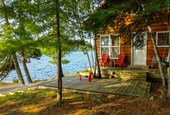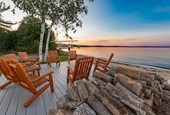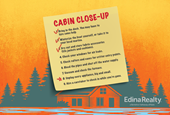
Key insights:
- Add insurance coverage to items that you use at your lake home, such as boats, docks and guest houses.
- Umbrella coverage or reduced content coverage may make the most sense. Consider alternative insurance options to meet your exact needs.
- Determine if flood insurance is necessary for your lake property.
Whether you buy a lake home for year-round living or summer retreats, the property will likely become your family’s oasis for rest and relaxation. To maintain this peaceful getaway, you’ll want to secure a homeowner’s insurance policy that helps manage risks and costs should the unforeseeable happen.
Rest assured that your property is protected by choosing an insurance plan that meets your specific needs. Here are tips to insure your Minnesota or western Wisconsin lake house without paying for extra coverage.
1. Get multiple quotes
Different insurance companies may have different rates for insuring lake homes or second homes, so you’ll want to get multiple quotes to determine who offers the strongest coverage at the best rate.
Here’s one example of how coverage and rates may vary by company: When insuring homes in lake country, some insurance companies may charge a lower premium if the property is in close proximity to the responding fire department. This is because when a fire department can get to the scene of a fire quickly, there is a lower chance of the entire property being damaged.
However, not all companies weigh the fire department location as heavily — and as a result, they may not offer the same coverage at a lower premium. To ensure that you’re getting the best coverage but not overpaying, shop around before selecting the best policy possible.
2. Include unattached buildings in your policy
Unlike your primary residence, waterfront homes may have additional buildings on the property, including:
- Bunkhouses
- Detached garages
- Large storage sheds
- Outhouses
- Docks
Limitations on separate structures vary by company, and typical homeowner policies may not cover the extra structures that you have at your lake home. You’ll want to increase your coverage to ensure these structures are fully protected.
3. Consider umbrella coverage
Just as your lake home may provide a relaxing retreat for you and your friends, it can also be the hub for riskier activities like bonfires, tubing and other outdoor fun. While you may go out of your way to ensure everyone is safe – especially when hosting guests – accidents happen.
You’ll likely be liable for injuries that occur on premises, so you’ll want to be adequately covered if or when accidents happen. An umbrella liability policy is an effective and relatively inexpensive way to get that coverage.
4. Insure all watercraft and vehicles
For many lake homeowners, exploring nearby trails and cruising around the lake adds to the fun of being at the lake. Keep in mind, additional motorized vehicles — on land or the water — typically aren’t covered under the homeowner’s insurance policy for a waterfront property.
Talk with your insurance provider to get these vehicles covered by separate policies:
- Boats
- Jet skis
- ATVs
- Golf carts
5. Reduce your personal content coverage
Generally lake homes have less personal property in them compared to primary homes. If a loss does occur, you’ll want to have brand-new items replaced within the lake home to get it back to normal as quickly as possible. Discuss with your local insurance professional if they have options to lower this coverage.
6. Insure semi-permanent water structures
If your lake home is situated directly on the water, you may have inherited or added semi-permanent water structures to the property. Some examples include:
- Swim rafts
- Water trampolines
- Boat lifts
- Seasonal docks
While you discuss your content coverage policy, ask your insurance agent about what coverage for these items might cost, and determine if you’d like to secure policies for them.
7. Consider additional flood insurance
When purchasing a property near the water, it’s important to ask questions specific to lakeshore homes. You’ll want to inquire about fluctuating water levels and any history of flooding; be sure to conduct your own research on the area as well.
As with your primary residence, homeowner’s insurance for a lakeshore property doesn’t cover flooding. If the property is susceptible to flooding, you should secure a flood insurance policy.
Ensure quality time with an insured home
With an insured waterfront property, you can have peace of mind that your house is fully protected. For more information on lakeshore homes, reach out to Edina Realty or your lakeshore agent. Moving forward with a REALTOR® is the best way to find and insure your dream home on the lake.
Edina Realty Insurance is an affiliate of Edina Realty. See Affiliated Business Arrangement Disclosure Statement.









